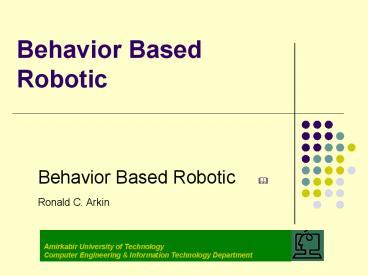Behavior Based Robotic - PowerPoint PPT Presentation
Title: Behavior Based Robotic
1
Behavior Based Robotic
??????? ????????
- ???? ???? ???? ??????
- ???? Behavior Based Robotic
- Ronald C. Arkin
2
?????
- Behavior-based roboticists argue that there is
much that can be gained for robotics through the
study of neuroscience, psychology, and ethology. - Neuroscience the study of the nervous system's
anatomy, physiology, biochemistry,and molecular
biology. - Psychology the study of mind and behavior
- Ethology the study of animal behavior in
natural conditions - The behavior-based roboticist needs to decide how
to use results from these - other disciplines. Some scientists attempt to
implement these results as closely - as possibly, concerning themselves primarily with
testing the underlying hypotheses of the
biological models in question. Others choose to
abstract the - underlying details and use these models for
inspiration to create more intelligent - robots, unconcerned with any impact within the
disciplines from which the original models arose.
We will see examples of both approaches within
this - book.
3
????? ???????
- Many different techniques and approaches for
robotic control have been developed. - Figme 1.10 depicts a spectrum of current robot
control strategies. The - left side represents methods that employ
deliberative reasoning and the right - represents reactive control. A robot employing
deliberative reasoning requires - relatively complete knowledge about the world and
uses this knowledge to - predict the outcome of its actions, an ability
that enables it to optimize its performance - relative to its model of the world. Deliberate
reasoning often requires - strong assumptions about this world model,
primarily that the knowledge upon - which reasoning is based is consistent, reliable,
and certain. If the information - the reasoner uses is inaccurate or has changed
since obtained, the outcome of - reasoning may err seriously. In a dynamic world,
where objects may be moving - arbitrarily (e.g., in a battlefield or a crowded
corridor), it is potentially dangerous - to rely on past information that may no longer be
valid. Representational - world models are therefore generally constructed
from both prior knowledge - about the environment and incoming sensor data in
support of deliberation.
4
Deliberative reasoning systems often have several
common characteristics
- They are hierarchical in structure with a clearly
identifiable subdivision of - functionality, similar to the organization of
commercial businesses or military - command.
- Communication and control occurs in a
predictable and predetermined manner, - flowing up and down the hierarchy, with little if
any lateral movement. - Higher levels in the hierarchy provide subgoals
for lower subordinate levels. - Planning scope, both spatial and temporal,
changes during descent in the - hierarchy. Time requirements are shorter and
spatial considerations are more - local at the lower levels.
- They rely heavily on symbolic representation
world models.
5
Reactive Systems
- The right side of the spectrum depicted in figure
1.10 represents reactive systems. - Simply put, reactive control is a technique for
tightly coupling perception - and action, typically in the context of motor
behaviors, to produce timely - robotic response in dynamic and unstructured
worlds. - We further define the following
- An individual behavior a stimulus/response
pair for a given environmental - setting that is modulated by attention and
detennined by intentio,n. - Attention prioritizes tasks and focuses
sensory resources and is detennined - by the current environmental context .
- Intention determines which set of behaviors
should be active based on the - robotic agent's internal goals and objectives .
- Overt or emergent behavior the global behavior
of the robot or organism as - a consequence of the interaction of the active
individual behavior
6
????? ??? ??????
- ??? ??????? ?????? ??????? ??? ????? ? ??? ??????
?????? ???? ????? ?? ????? ? ?? ?????? ???
??????? ????? ??????. - ??????? ???? ???? ????? ??? ???
- ??????? ????? ???? ???? ? ?? ??? sensorimotor
????? ???? ???? ??































